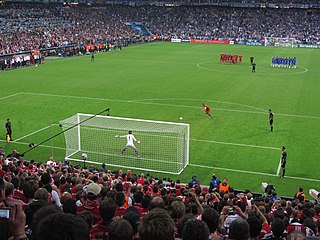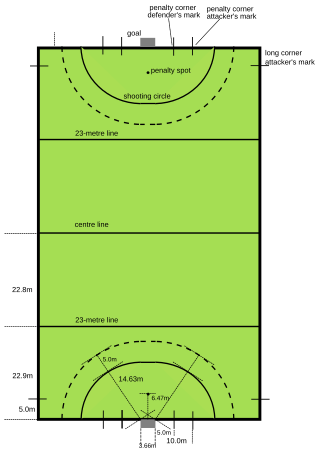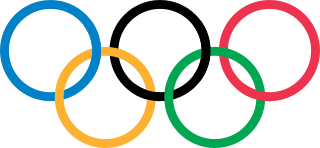Related Research Articles

Field hockey is a team sport structured in standard hockey format, in which each team plays with 11 players in total, made up of 10 field players and a goalkeeper. Teams must move a hockey ball around a field by hitting it with a hockey stick towards the rival team's shooting circle and then into the goal. The match is won by the team that scores the most goals. Matches are played on grass, watered turf, artificial turf, or indoor boarded surface. Street hockey is a form of impromptu field hockey typically played by children in Canada, via erecting a net in the street and using the road surface to play.
The golden goal is a rule used in association football, rugby league, lacrosse, field hockey, and ice hockey to decide the winner of a match in which scores are equal at the end of normal time. It is a type of sudden death. Under this rule, the game ends when a goal or point is scored; the team that scores that goal or point during extra time is the winner. Introduced formally in 1993, though with some history before that, the rule ceased to apply to most FIFA-authorized football games in 2004. The similar silver goal supplemented the golden goal between 2002 and 2004.

In many team sports that involve scoring goals, the goalkeeper is a designated player charged with directly preventing the opposing team from scoring by blocking or intercepting opposing shots on goal. Such positions exist in bandy, rink bandy, camogie, association football, Gaelic football, international rules football, floorball, handball, hurling, field hockey, ice hockey, roller hockey, lacrosse, ringette, rinkball, water polo, and shinty, as well as in other sports.

In association football, a penalty shoot-out is a tie-breaking method to determine which team is awarded victory in a match that cannot end in a draw, when the score is tied after the normal time as well as extra time has expired. In a penalty shoot-out, each team takes turns shooting at goal from the penalty mark, with the goal defended only by the opposing team's goalkeeper. Each team has five shots which must be taken by different players; the team that makes more successful kicks is declared the victor. Shoot-outs finish as soon as one team has an insurmountable lead. If scores are level after five pairs of shots, the shootout progresses into additional "sudden-death" rounds. Balls successfully kicked into the goal during a shoot-out do not count as goals for the individual kickers or the team, and are tallied separately from the goals scored during normal play. Although the procedure for each individual kick in the shoot-out resembles that of a penalty kick, there are some differences. Most notably, neither the kicker nor any player other than the goalkeeper may play the ball again once it has been kicked.

Indoor hockey is an indoor variant of field hockey. It is similar to the outdoor game in that two teams compete to move a hard ball into the goal of the opposing side using hockey sticks. Indoor hockey is played on a smaller area and between smaller teams than field hockey and the sidelines are replaced by solid barriers from which the ball rebounds and remains in play.

Field hockey was introduced at the Olympic Games as a men's competition at the 1908 Games in London. India has been the most successful team at the Olympics, having won a total of 12 medals.

In field hockey, a penalty corner, sometimes known as a short corner, is a penalty given against the defending team. It is predominantly awarded for a defensive infringement in the penalty circle or for a deliberate infringement within the defensive 23-metre area. They are eagerly sought by attacking players and provide an excellent opportunity to score. There are particular rules for that only apply at penalty corners and players develop specialist skills, such as the drag flick, for this particular phase in the game.

The United States women's national field hockey team, represents the United States in international field hockey. The team is currently coached by David Passmore. It made its first international appearance in 1920 when a touring team visited England, coached by Constance M.K. Applebee. The team made several international appearances in the early 20th century, leading to the United States hosting the eighth International Federation of Women's Hockey Associations Tournament in 1963. Once the IFWHA merged with its counterpart on the men's side, the United States' first appearance at an FIH-sanctioned tournament was the 1983 Women's Hockey World Cup in Kuala Lumpur, Malaysia, where the Americans ended up in sixth place. They have won bronze at the Los Angeles 1984 Summer Olympics and bronze at the 1994 World Cup.

The United States men's national field hockey team represents the United States in the international field hockey competitions. The governing body is the United States Field Hockey Association (USFHA), which is a US Olympic Committee organization.
Field hockey at the 2008 Summer Olympics in Beijing was held over a fourteen-day period beginning on 10 August, culminating with the medal finals on 22 and 23 August. All games were played at the hockey field constructed on the Olympic Green.

Field hockey at the 2016 Summer Olympics in Rio de Janeiro took place from 6 to 19 August at the Olympic Hockey Centre in Deodoro. The competition had instituted several changes in the format and structure from the 2012 Summer Olympics. Twenty-four teams competed in the tournament.
The 1973 Men's Hockey World Cup was the second installment of the Hockey World Cup. It was held from 24 August to 2 September at the Wagener Stadium in Amstelveen, Netherlands. The tournament was won by host nation the Netherlands, who defeated India 4–2 on penalty strokes after the final had finished 2–2. It was the first World Cup to introduce the 12 teams format which became the standard format of the FIH Hockey World Cup until the 1998 edition.

A hockey pitch is the playing surface for the game of field hockey. Historically, the game was played on natural turf (grass) and nowadays it is predominantly played on an artificial turf. The transition to artificial pitches came during the 1970s and was made mandatory for major competitions in 1976. All the lines, markings and goal specifications are outlined by the International Hockey Federation in "The Rules of Hockey".

In field hockey, a penalty stroke, sometimes known as a penalty flick, is the most severe penalty given. It is predominantly awarded when a foul has prevented a certain goal from being scored or for a deliberate infringement by a defender in the penalty circle.

The women's field hockey tournament at the 2016 Summer Olympics was the tenth edition of the field hockey event for women at the Summer Olympics. It took place over a fourteen-day period beginning on 6 August, and culminating with the medal finals on 19 August. All games were played at the Olympic Hockey Centre in Deodoro, Rio de Janeiro, Brazil.
The men's field hockey tournament at the 2015 Pan American Games was held in Toronto, Canada at the Pan Am / Parapan Am Fields from July 14 to 25.
The women's field hockey tournament at the 2015 Pan American Games was held in Toronto, Canada at the Pan Am / Parapan Am Fields from July 13 to 24.

The 2018 Men's Hockey World Cup Final was a field hockey match played between Belgium and the Netherlands on 16 December 2018 at the Kalinga Stadium in Bhubaneswar, India.
Leon Hayward is an Australian-born New Zealand field hockey player, who plays as a goalkeeper.

The field hockey tournaments at the 2024 Summer Olympics in Paris are scheduled to run from 27 July to 9 August at Stade Yves-du-Manoir, a legacy venue of the 1924 Summer Olympics. Twenty-four teams will compete against each other in their respective tournaments.
References
- ↑ "Beeston crowned champions with win over Surbiton". BBC Sport. 14 April 2013. Retrieved 20 April 2014.
- 1 2 3 Rules of Hockey. International Hockey Federation. 2002. pp. 59–61 Appendix F.
- 1 2 3 4 5 FIH. "Penalty Shoot Out Regulation" (PDF). Field Hockey Nova Scotia . Retrieved 20 April 2014.[ permanent dead link ]
- 1 2 "Uhlenhorster win Euro Hockey League". International Hockey Federation. 11 May 2011. Retrieved 20 April 2014.
- 1 2 3 4 5 "Shootouts to make FIH debut". International Hockey Federation. 4 April 2011. Retrieved 20 April 2014.
- ↑ "Hockive". National Hockey Museum. Retrieved 20 April 2014.
- ↑ "Las Leonas del pasado". El Gráfico (in Spanish). 15 November 2010. Retrieved 20 April 2014.
El tercer Mundial, España 78, dejó la curiosidad de que el partido por el tercer puesto nunca terminó: Argentina y Bélgica empataron 0-0 y no hubo penales por falta de luz.
- ↑ Singh, Jaideep (28 September 2000). "Shoot out the shoot-out: Walsh". Rediff.com . Retrieved 21 April 2014.
- ↑ "Belgium claims Champions Challenge 2 title". International Hockey Federation. 15 May 2011. Retrieved 20 April 2014.
- ↑ "Scotland snags bronze in shootout". International Hockey Federation. 26 June 2011. Retrieved 20 April 2014.
- ↑ "Penalty drama as Netherlands win Rabo FIH Champions Trophy". International Hockey Federation. 3 July 2011. Retrieved 20 April 2014.
- ↑ "Olympics hockey: Netherlands win hockey shoot-out". BBC Sport. 8 August 2012. Retrieved 20 April 2014.
- ↑ Benammar, Emily (8 August 2012). "London 2012 Olympics: Holland reach women's hockey final after penalty shoot-out win over New Zealand". The Daily Telegraph . Retrieved 20 April 2014.
